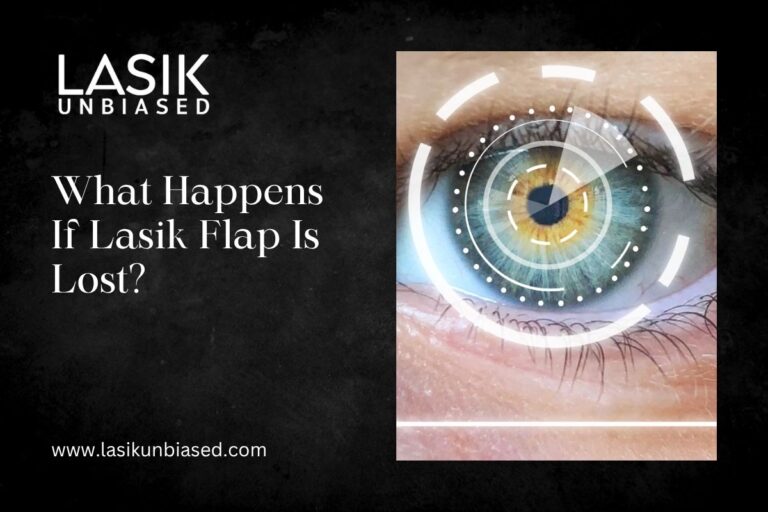If a LASIK flap is lost, it can lead to significant vision problems, including haze, irregular astigmatism, and even permanent vision loss if not managed quickly and properly.
Immediate medical attention is essential to preserve eye health and maximise the chances of a good visual outcome.
LASIK surgery is generally safe, but like any surgical procedure, it carries rare but serious risks. One of the most concerning complications is the loss of the corneal flap created during the procedure. If you’re considering LASIK or have recently undergone it, understanding what happens if the LASIK flap is lost can help you respond quickly and protect your sight.
Understanding the LASIK Flap and Its Importance
What Is the LASIK Flap?
During LASIK, a surgeon creates a thin, hinged flap on the surface of your cornea. This flap is lifted so a laser can reshape the underlying tissue, correcting vision problems like nearsightedness, farsightedness, and astigmatism. Afterwards, the flap is repositioned, acting as a natural bandage to speed up healing and reduce discomfort.
Why Is the Flap So Crucial?
The flap’s integrity is vital for optimal visual outcomes. It protects the treated area, helps the eye heal, and maintains corneal stability. Because the flap is only loosely attached, especially in the days and weeks after surgery, it’s at risk of becoming dislodged or lost due to trauma or improper care.
How Does LASIK Flap Loss Happen?
Common Causes of LASIK Flap Loss
A lost LASIK flap is rare, but several scenarios can trigger it:
- Trauma: Direct impact to the eye (sports injuries, accidental pokes) is the most common cause.
- Rubbing the Eye: Rubbing your eye vigorously, especially soon after surgery, can dislodge or detach the flap.
- Dry Eye or Poor Healing: Conditions that impair healing can make the flap more vulnerable.
- Surgical Complications: Device malfunction or incomplete flap creation can increase risk.
When Is the Flap Most Vulnerable?
The risk is highest in the first 24–48 hours after surgery, although the flap may remain more vulnerable to trauma for several weeks or even months. Most patients can resume normal activities after a week, but they should avoid trauma and rubbing for several weeks.
Recognising the Symptoms of a Lost LASIK Flap
How Can You Tell If the Flap Is Lost?
Symptoms may include:
- Sudden vision changes (blurred or distorted vision)
- Eye pain or discomfort
- Redness and swelling
- Sensitivity to light
- Excessive tearing
- Feeling like something is in your eye
Sometimes, a lost or dislodged flap may not cause immediate pain but can still threaten your vision. That’s why regular follow-up appointments are critical after LASIK.
Immediate Steps: What To Do If You Suspect Flap Loss?
Why Is Quick Action So Important?
If you notice any symptoms of flap loss, seek emergency eye care immediately. Delaying treatment can lead to permanent vision changes, infection, or scarring.
What Will the Eye Doctor Do?
- Examine your eye to assess the flap’s condition.
- Use specialised instruments to reposition the flap if possible.
- Prescribe medications (antibiotics, steroids) to reduce inflammation and prevent infection.
- Apply a bandage contact lens to protect the cornea during healing.
Treatment Options for Lost LASIK Flap
1. Flap Repositioning
If the flap is found and still viable, your surgeon may carefully reposition it and secure it with a bandage contact lens or, rarely, sutures. This is the preferred option and can restore vision close to pre-injury levels, though some haze or minor imperfections may remain.
2. Natural Healing
If the flap is lost or too damaged to reposition, the cornea will heal on its own. The surgeon may use a bandage contact lens and prescribe medications to help the surface regenerate. However, this often leads to:
- Irregular astigmatism (distorted vision)
- Corneal haze (cloudiness)
- Need for glasses or contact lenses for best vision
3. Alternative Surgeries
In severe cases, further procedures may be needed:
- Phototherapeutic Keratectomy (PTK): Uses a laser to smooth the corneal surface.
- Corneal Transplant: Extremely rare, but may be considered in cases of severe scarring or corneal failure when other treatments don’t work.
Potential Complications from LASIK Flap Loss
What Are the Risks If the Flap Is Lost?
- Infection: The exposed corneal tissue is more vulnerable to bacteria, which can cause serious, sight-threatening infections.
- Irregular Astigmatism: Loss of the flap can create an uneven corneal surface, leading to blurred or distorted vision.
- Corneal Scarring: Haze or permanent scars can develop, reducing clarity.
- Decreased Visual Acuity: Some patients may not regain their previous level of vision, even with corrective lenses.
Long-Term Outlook
With prompt and expert care, many patients recover useful vision, but outcomes vary. Some may need corrective lenses or additional surgery for best results. Regular follow-up and adherence to post-surgical care are essential for optimal recovery.
Prevention: How to Minimise the Risk of Flap Loss?
Steps You Can Take
- Follow Post-Op Instructions: Avoid rubbing your eyes, swimming, or contact sports until your doctor gives the all-clear.
- Wear Protective Eyewear: Use safety glasses during activities that could expose your eyes to trauma.
- Attend All Follow-Ups: Early detection of any issues allows for faster, more effective treatment.
For Surgeons
- Use up-to-date technology and meticulous technique.
- Carefully screen patients for risk factors (thin corneas, previous surgeries, certain medical conditions).
- Educate patients thoroughly about aftercare.
Key Takeaways
- Losing a LASIK flap is rare but serious.
- Immediate medical attention is critical for the best chance of recovery.
- Treatment may involve flap repositioning, natural healing, or further surgery.
- Prevention through careful aftercare and follow-up is your best protection.
If you’ve had LASIK and notice sudden vision changes, pain, or discomfort, don’t wait—contact your eye surgeon or seek emergency care right away. Your quick response can make all the difference in preserving your sight.
Thinking about LASIK or have questions about your recovery? Schedule a consultation with a trusted ophthalmologist to discuss your concerns and ensure your eyes get the best possible care.
Frequently Asked Questions About LASIK Flap Loss
How common is flap loss after LASIK?
Flap loss is very rare, especially with modern surgical techniques. Flap dislocation or related complications occur in about 1-2% of cases, with actual flap loss being even less frequent.
Will my vision ever be the same if I lose my LASIK flap?
Outcomes depend on how quickly you receive treatment and the extent of the damage. Many patients regain good vision, but some may experience permanent changes or need corrective lenses.
Can a lost flap be replaced?
If the flap is intact and found quickly, it can often be repositioned. If it’s lost entirely, the cornea will heal, but vision may not be as sharp as before.
How long does it take for the LASIK flap to heal?
The outer edges seal within a day or so, but full healing can take several weeks to months. The flap is most vulnerable in the first few days after surgery.


